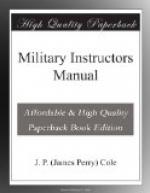(1) TEAR, OR LACHRYMATORY SHELLS:
These shells on explosion drive the liquid chemical which they contain into the air as a mist. They cause the eyes to water strongly and thereby gradually put men out of action.
Their actual smell may be slight. Large concentrations of lachrymators begin to affect the lungs and cause sickness, coughing and general irritation.
(2) POISON SHELLS:
Besides the comparatively harmless lachrymators the enemy also uses projectiles which contain a gas, the action of which is very similar to that of phosgene. Because of their slight detonation, these shells are liable to be mistaken for blinds, but they emit large quantities of a gas which attacks the lungs strongly and is very dangerous, and even in slight cases may cause serious after effects.
(3) SMOKE:
The enemy may make use of smoke, either in the form of a cloud or emitted from shells and bombs. Smoke may be used with gas or between gas clouds; it may also be used alone to distract attention from a real discharge of gas, to cover the advance of infantry, or merely as a false gas attack.
(4) MINE AND EXPLOSION GASES:
The poisonous gases which occur in mines, and which are formed in large quantities when high explosive goes off in an enclosed space, e.g., from a direct hit in a shelter, or on the explosion of a charge in a mine, are not protected against by the ordinary anti-gas appliances. The chief of these gases is carbon monoxide. Protection against such gases will not be considered in these notes.
Officers are held responsible that all the anti-gas appliances for protecting their men are maintained in perfect condition, and that all ranks under their command are thoroughly trained in the use of these appliances and in all other measures which may affect their safety against gas.
Summary of Protective Measures:
(a) Provision to each man of individual
protective devices.
(b) Arrangement for the inspection
of those appliances and training
in their
use and instruction in all other measures of gas
defense.
(c) Provision of protected and gas-proof
shelters.
(d) Weather observations to determine
periods when the conditions
are favorable
to a hostile gas attack.
(e) Arrangement of signals and messages;
for immediate warning of a
gas attack.
(f) Provision of appliances for
clearing gas from trenches and
shelters.
C. Protection of Shelters:
(1) METHODS OF PROTECTION:
Protection of dugouts, cellars, buildings, etc., is given if all entrances are closed by well-fitting doors or by blankets sprayed with hypo. solution. Practically no gas passes through a wet blanket, and the protection depends on getting a good joint at the sides and bottom of a doorway, so as to stop all draughts. This can be effected by letting the blanket rest on battens, fixed with a slight slope, against the door frame. The blanket should overlap the outer sides and a fold should lie on the ground at the bottom. A pole is fastened to the blanket, which allows the latter to be rolled up on the frame and causes it to fall evenly.




